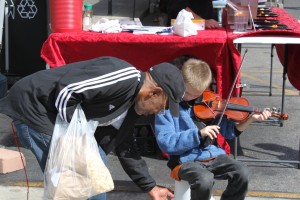Since the spectacularly successful renovation of Pike Place Market in the 1970’s, roughly 200 new, permanent, indoor Public Markets have been created. All but a handful of these have been extremely successful. For those that have failed, poor planning and/or unreasonable private developer financial or timing assumptions have generally been to blame.
Cincinnati’s Findlay Market thrives as one of the City’s main attractions following a complete overhaul designed by this website’s author.
Many qualities combine to create a successful Public Market. These include:
1) Excellent planning – Developing Public Markets is not like other forms of retail/commercial development. Each Public Market is unique and requires planning assistance from a skilled consultant with deep experience in Public Market development. Planning should include a professionally prepared Feasibility Study and Site Analysis. In creating a new or significantly renovated Public Market, a comprehensive Business Plan should be developed which should provide a complete roadmap from the conceptual stage to the Grand Opening.
 Pike Place Market on a ‘slow’ day
Pike Place Market on a ‘slow’ day
2) An excellent site and location – Not all sites are created equal. While a properly planned Public Market can be a regional destination, suitable location and access are critical. In developing a new Public Market, a thorough Site Analysis should be professionally prepared. Ideally, a Public Market should not be located in anyone’s specific “turf” – so that it can become “everyone’s turf”.
3) Size – The size of the Public Market needs to be appropriately scaled to the customer community that it is intended to serve. While successful Public Markets have ranged from 6,000 square feet to over 400,000 square feet, Public Markets need to be large enough to create an attractive critical mass of uses that will keep customers coming back. Remember that many of the best Public Markets succeed because a majority of their customers shop there weekly for fresh foods.

Opportunities for Minority Vendors
4) A diverse, vital, and culturally rich larger community – Some communities embrace diverse foods and culture while other communities are more “white Wonder Bread” in their orientation. Public Markets tend to do better in the former kind of community.
5) Great tenant mix and design layout – tenants need to be selected based on their likely contribution to the overall planned mix. A detailed Tenant Leasing Plan and Design Program should be part of the Business Plan.
6) Engaged professional management that understands the mission of the Market and the makeup of its community – Anyone who has successfully managed a Public Market will affirm that a very different skill set is needed than that needed to manage a supermarket or mall.
7) An intensive, professional, institutional advertising program that includes advertising, special events, and public relations – this needs to be in place before the Public Market opens.
8) The Public Market needs to reflect its community’s character and heritage while meeting its everyday shopping need – especially for fresh foods.
There is another ‘secret’ to the creation of a successful Public Market.
This one may be the most important of all. This ‘secret’ is embodied in the following anecdote:

Friendly Merchants
While a Director at Seattle’s Pike Place Market, the owner of this website helped commission a customer intercept survey where customers in the Public Market and in a nearby mall were asked, “Why did you come down here today” and “How much did you spend here today”.
At the mall, 94% of respondents said one form or another of “I came to shop”. “I needed to buy a vacuum cleaner bag and this was the place to get it.”
In contrast, at the Public Market, only 26% of respondents “came to shop”.

Supporting Communities
Customers came to ‘their’ Public Market for “the experience”. They happily came for fundamentally social reasons – to meet a friend, to people watch, to enjoy the street musicians, to mix with people who were different from themselves.
They came to be immersed in a vibrant, pulsing, colorful place that was exciting and fun. They came for the free flu shots or the ethnic festival. They came to show their kids where food really comes from, and, that meat does not grow in a Styrofoam container, nor, bread in a plastic bag!
Despite the fact that Public Market customers “didn’t come to shop”, they spent nearly double what mall shoppers spent per customer visit!
Putting this ‘nugget’ into practice has allowed Public Markets to succeed at leading the revitalization of dozens of communities nationwide.